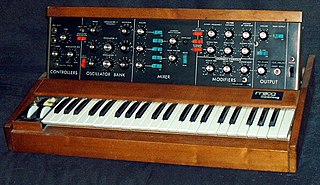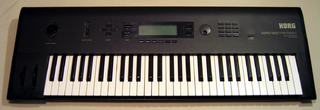
A digital synthesizer is a synthesizer that uses digital signal processing (DSP) techniques to make musical sounds. This in contrast to older analog synthesizers, which produce music using analog electronics, and samplers, which play back digital recordings of acoustic, electric, or electronic instruments. Some digital synthesizers emulate analog synthesizers; others include sampling capability in addition to digital synthesis.

Digital music technology encompasses the use of digital instruments, computers, electronic effects units, software, or digital audio equipment by a performer, composer, sound engineer, DJ, or record producer to produce, perform or record music. The term refers to electronic devices, instruments, computer hardware, and software used in performance, playback, recording, composition, mixing, analysis, and editing of music.

An analog synthesizer is a synthesizer that uses analog circuits and analog signals to generate sound electronically.
Wavetable synthesis is a sound synthesis technique used to create quasi-periodic waveforms often used in the production of musical tones or notes.
A music workstation is an electronic musical instrument providing the facilities of:

A sampler is an electronic musical instrument that records and plays back samples. Samples may comprise elements such as rhythm, melody, speech, sound effects or longer portions of music.

An electronic keyboard, portable keyboard, or digital keyboard is an electronic musical instrument based on keyboard instruments. Electronic keyboards include synthesizers, digital pianos, stage pianos, electronic organs and digital audio workstations. In technical terms, an electronic keyboard is a rompler-based synthesizer with a low-wattage power amplifier and small loudspeakers.
The Ensoniq Mirage is one of the earliest affordable sampler-synths, introduced in 1984 as Ensoniq's first product. Introduced at a list price of $1,695 with features previously only found on more expensive samplers like the Fairlight CMI, the Mirage sold nearly 8,000 units in its first year - more than the combined unit sales of all other samplers at that time. The Mirage sold over 30,000 units during its availability.

The Roland D-50 is a synthesizer produced by Roland and released in April of 1987. Its features include digital sample-based subtractive synthesis, on-board effects, a joystick for data manipulation, and an analog synthesis-styled layout design. The external Roland PG-1000 (1987) programmer could also be attached to the D-50 for more complex manipulation of its sounds. It was also produced in a rack-mount variant design, the D-550, with almost 450 user-adjustable parameters.
A rompler is an electronic musical instrument that plays pre-fabricated sounds based on audio samples. The term rompler is a blend of the terms ROM and sampler. In contrast to samplers, romplers do not record audio. Both may have additional sound editing features, such as layering several waveforms and modulation with ADSR envelopes, filters and LFOs.

Ensoniq ESQ-1 is a 61-key, velocity sensitive, eight-note polyphonic and multitimbral synthesizer released by Ensoniq in 1985. It was marketed as a "digital wave synthesizer" but was an early Music Workstation. Although its voice generation is typically subtractive in much the same fashion as most analog synthesizers that preceded it, its oscillators are neither voltage nor "digitally controlled", but true digital oscillators, provided by a custom Ensoniq wavetable chip. The signal path includes analog resonant low-pass filters and an analog amplifier.
The Yamaha AN1x is a DSP-based analog modeling synthesizer, produced by Yamaha Corporation from 1997 to 1998, and was marketed as an "analog physical modelling control synthesizer".
Elektron is a Swedish developer and manufacturer of musical instruments founded in 1998, as well as having its headquarters, R&D and production in Gothenburg, Sweden. They produce mainly electronic musical instruments, but have also made effects units and software. Since 2012, there have been branch offices in Los Angeles and in Tokyo.
Monotimbral is usually used in reference to electronic synthesizers which can produce a single timbre at a given pitch when pressing one key or multiple keys.

The microKORG is a MIDI-capable digital synthesizer/vocoder from Korg featuring DSP-based analog modelling. The synthesizer is built in such a way that it is essentially a Korg MS-2000 with a programmable step arpeggiator, a less advanced vocoder, lack of motion sequencing, lack of an XLR microphone input, and in a smaller case with fewer real-time control knobs.

Palm Products GmbH was a manufacturer of audio synthesizers. Founded and owned by Wolfgang Palm, PPG was located in Hamburg, Germany and, for 12 years from around 1975 to 1987, manufactured an acclaimed and eclectic range of electronic musical instruments, all designed by Palm.

The Korg Wavestation is a vector synthesis synthesizer first produced in the early 1990s and later re-released as a software synthesizer in 2004. Its primary innovation was Wave Sequencing, a method of multi-timbral sound generation in which different PCM waveform data are played successively, resulting in continuously evolving sounds. The Wavestation's "Advanced Vector Synthesis" sound architecture resembled early vector synths such as the Sequential Circuits Prophet VS.

A synthesizer is an electronic musical instrument that generates audio signals. Synthesizers typically create sounds by generating waveforms through methods including subtractive synthesis, additive synthesis and frequency modulation synthesis. These sounds may be altered by components such as filters, which cut or boost frequencies; envelopes, which control articulation, or how notes begin and end; and low-frequency oscillators, which modulate parameters such as pitch, volume, or filter characteristics affecting timbre. Synthesizers are typically played with keyboards or controlled by sequencers, software or other instruments, and may be synchronized to other equipment via MIDI.

The PPG Wave is a series of synthesizers built by the German company Palm Products GmbH from 1981 to 1987.

The CZ series is a family of low-cost phase distortion synthesizers produced by Casio in the mid-1980s. Eight models of CZ synthesizers were released: the CZ-101, CZ-230S, CZ-1000, CZ-2000S, CZ-2600S, CZ-3000, CZ-5000, and the CZ-1. Additionally, the home-keyboard model CT-6500 used 48 phase distortion presets from the CZ line. The CZ synthesizers' price at the time of their introduction made programmable synthesizers affordable enough to be purchased by garage bands. Yamaha soon introduced their own low-cost digital synthesizers, including the DX-21 (1985) and Yamaha DX100, in light of the CZ series' success.











